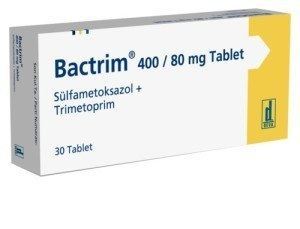Prescription Bactrim is a popular antibiotic for humans, but is this drug is OK for a dog’s bacterial infection?
Too dangerous? Just how risky is it?
Here’s the deal:
 Pets generally respond well to Bactrim. It works for dogs too. However, this type of treatment requires a vet’s expertise.
Pets generally respond well to Bactrim. It works for dogs too. However, this type of treatment requires a vet’s expertise.
Dogs Can Take Bactrim
It is fairly safe following a diagnosis, vet’s authorization and their detailed instructions.
Bactrim is actually well-utilized for treating dogs.
At the same time, there are well-documented side effects. Don’t chance it!
9-Year Study’s Findings
Utrecht University did a retrospective analysis of trimethoprim-sulphonamide (T-S) combinations on 19 dogs.
The results?
Dermatological and systemic reactions were confirmed. It’s the nature of antibiotics.
The good news is the adverse reaction incidence rate was only 0.25%
Cautious K9 Treatment
Despite the risks, this drug is very effective for urinary tract infections (UTIs).
Basically, Bactrim inhibits growth of harmful microorganisms. Then, it kills them off!
It can also be given to dogs for:
- Cystitis
- Certain skin infection
- Kennel cough
- Pneumonia
Warning: Never give Bactrim to a pregnant or lactating dog or those suffering from a liver or kidney disease.
Know The Side Effects
Bactrim can cause poisoning, hypersensitivity and various allergic reactions.
Serious complications are possible.
Common canine complications include diarrhea and vomiting.
Your dog may also:
- Get a rash
- Have reduced appetite
- Have difficulty breathing
- Have swelling of the tongue, lips and/or face
That’s not all…
Watch for signs of blood in their stool and urine (a sign of internal bleeding).
A strong indicator of liver damage would be if your dog’s eyes are yellowish after taking Bactrim or any broad spectrum antibiotic.
Bactrim Dosing Info
It’s important to provide your dog with an appropriate Bactrim dose.
Talk with a veterinarian for the correct amount (as well as the treatment’s duration).
Several factors go into determining a dose. These include:
- Overall health
- Breed
- The dog’s age
- Their size (weight)
- The type of infection and;
- The pet’s response to the drug
A wide range of 12mg to 50mg per pound of Bactrim is considered acceptable.
But again, dosing depends on the dog’s particular situation.
Your vet may recommend increasing (or decreasing) dosage at a later time. Follow that advice!
Delivering This Drug
There are several ways to give Bactrim or generic equivalent.
The most popular way to administer this antibiotic is to crush up tablets. This way you can mix the contents with dog food.
Pressing the pill down your dog’s throat is another option (assuming you’re comfortable doing so).
FYI: Sometimes Bactrim needs to be provided intravenously, intramuscularly or subcutaneously.
Taken With Other Meds
There are also contraindications associated with taking Bactrim.
Yes, this applies to dogs too!
Aspirin, for example, should not be taken with Trimethoprim/sulfamethoxazole.
Starting to see that Bactrim treatment isn’t so simple?
The Bottom Line
Bactrim is considered safe enough for dogs (when it’s used responsibly).
Vets prescribe this antibiotic for various infections, but a diagnosis is an absolute must.
You must be very familiar with side effects.
And monitoring of your dog is essential while they are on this prescription and never, ever administer your own supply of Bactrim.
